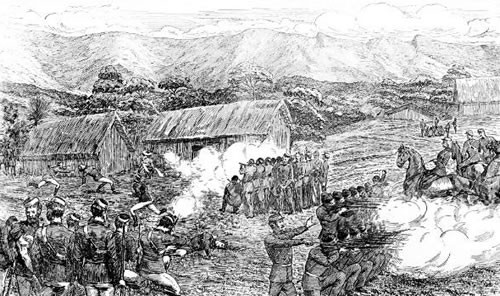
The fight at Rangiaohia for the recovery of McHale’s body. February 21 1864, by L.A. Wilson. This artist’s impression of the fight at Rangiaowhia shows the fall of Colonel Marmaduke Nixon (top, second from left). Captain Thomas McDonnell (left) runs to help Nixon, while Lieutenant-General Duncan Cameron and his staff are shown at right.
The inhabitants of Rangiaowhia, in the economic heartland of the Kīngitanga, were surprised on the morning of Sunday 21 February 1864 by the arrival of imperial and colonial soldiers. Most of Rangiaowhia’s fighting men were still at nearby Pāterangi, which Cameron’s force had bypassed overnight. Many inhabitants took refuge in one of Rangiaowhia’s two churches, while others ran for their whare (houses).
Sergeant McHale, ‘an excited cavalryman’, was shot and killed when he fired into one of the whare. So was a soldier of the 65th Regiment. The building was surrounded and two ranks of men opened fire. Those inside returned fire, mortally wounding Colonel Nixon. Then another trooper was shot while trying to retrieve McHale’s body.
Whether by accident or design, the thatch of the building caught fire. An unarmed elderly man came out with a white blanket raised above his head. He was killed by a hail of bullets despite calls from a nearby officer to ‘spare him’. Two more Māori attempting to escape met a similar fate, and eight charred corpses (including that of McHale) were later found in the smoking ruins.

Community contributions